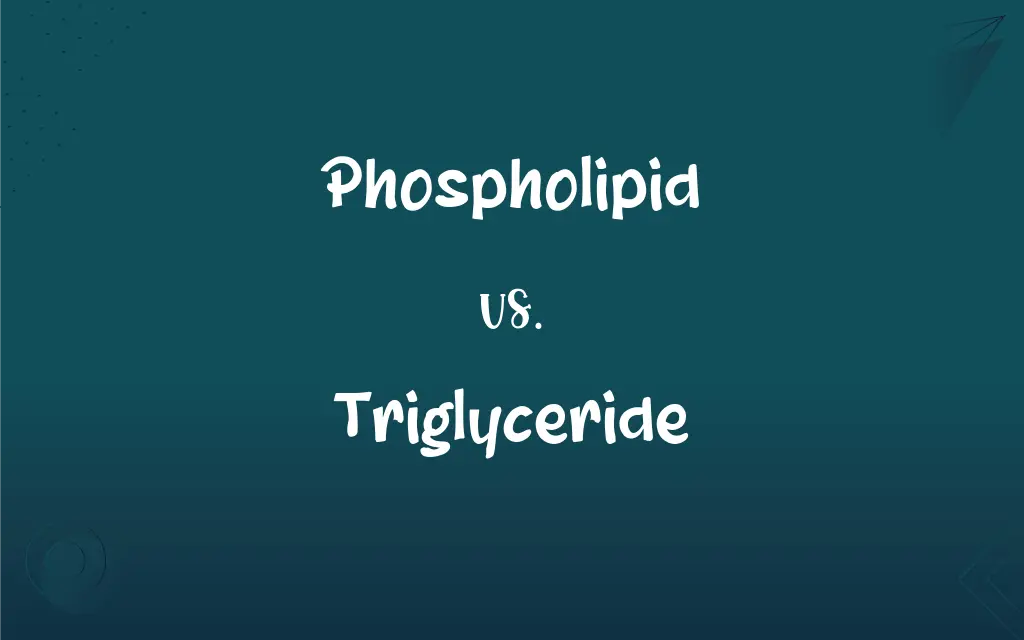Phospholipid vs. Triglyceride: What's the Difference?
Edited by Harlon Moss || By Janet White || Published on December 28, 2023
Phospholipids are a major component of cell membranes with a hydrophilic head and two hydrophobic tails, while triglycerides are the main form of stored fat in the body.

Key Differences
Phospholipids are essential for cell membrane structure, featuring a polar, hydrophilic head and two nonpolar, hydrophobic fatty acid tails. Triglycerides, composed of three fatty acids linked to a glycerol molecule, are the primary form of fat storage in the body.
In phospholipids, the hydrophilic head interacts with water, while the hydrophobic tails avoid it, forming bilayers in cell membranes. Triglycerides, being entirely hydrophobic, are stored in adipose tissue and do not form bilayers.
Phospholipids play a critical role in cell signaling and membrane fluidity. Triglycerides serve as a major energy source, releasing energy upon hydrolysis.
The amphipathic nature of phospholipids makes them ideal for forming the semi-permeable membranes of cells. Triglycerides, due to their energy-rich composition, are crucial for long-term energy storage.
In metabolic processes, phospholipids are involved in membrane transport and flexibility. Triglycerides, when broken down, provide fuel for cellular activities and help in thermoregulation.
ADVERTISEMENT
Comparison Chart
Structure
Glycerol, two fatty acids, and a phosphate group
Glycerol bonded to three fatty acids
Role in the Body
Cell membrane structure and signaling
Energy storage and insulation
Solubility
Amphipathic (partly soluble)
Hydrophobic (not soluble in water)
Biological Function
Forms cell membranes, aids in cell communication
Stores energy, provides thermal insulation
Physical Properties
Forms bilayers in water
Forms fat droplets in cells
ADVERTISEMENT
Phospholipid and Triglyceride Definitions
Phospholipid
Amphipathic molecules forming the cell membrane.
Phospholipids create a barrier between the inside and outside of a cell.
Triglyceride
A type of fat found in blood and the main form of fat stored in the body.
High triglyceride levels can indicate health issues.
Phospholipid
Lipids that make up the bilayer of cell membranes.
Phospholipids allow for the selective permeability of membranes.
Triglyceride
Molecules composed of three fatty acids and one glycerol.
Triglycerides are broken down for energy during fasting.
Phospholipid
Molecules with a hydrophilic head and hydrophobic tails.
The unique structure of phospholipids helps in forming vesicles.
Triglyceride
The main constituents of body fat in humans and animals.
Triglycerides are stored in adipose tissue for energy use.
Phospholipid
Essential components in membrane fluidity and signaling.
Phospholipids adapt to maintain the fluidity of cell membranes.
Triglyceride
A form of lipid involved in metabolic processes.
Measuring triglycerides helps assess cardiovascular health.
Phospholipid
A lipid containing a phosphate group in its molecule.
Phospholipids are crucial for maintaining cell membrane integrity.
Triglyceride
Lipids used for long-term energy storage.
Triglycerides provide insulation and protect organs in the body.
Phospholipid
Any of various phosphorus-containing lipids, such as lecithin and cephalin, that are composed mainly of fatty acids, a phosphate group, and a simple organic molecule. Also called phosphatide.
Triglyceride
Any of a class of compounds that consist of an ester of glycerol with three fatty acids and that are the chief constituents of fats and oils.
Phospholipid
(organic compound) Any lipid, such as lecithin or cephalin, consisting of a diglyceride combined with a phosphate group and a simple organic molecule such as choline or ethanolamine; they are important constituents of biological membranes.
Triglyceride
(organic chemistry) A lipid, an ester of glycerol and three fatty acids (the same or different); the major constituent of animal and vegetable fats
Phospholipid
Any of various compounds composed of fatty acids and phosphoric acid and a nitrogenous base; an important constituent of membranes
Triglyceride
A glyceride formed by the replacement of three hydrogen atoms in glycerin by acid radicals.
Triglyceride
Glyceride occurring naturally in animal and vegetable tissues; it consists of three individual fatty acids bound together in a single large molecule; an important energy source forming much of the fat stored by the body
FAQs
How do phospholipids function in cell membranes?
They form bilayers, with hydrophilic heads facing outward and hydrophobic tails inward, creating a barrier that separates the cell from its environment.
What are phospholipids?
Phospholipids are a class of lipids that are a major component of all cell membranes.
Are phospholipids hydrophobic or hydrophilic?
Phospholipids are amphipathic, meaning they have both hydrophobic and hydrophilic parts.
What is the structure of a phospholipid?
A phospholipid molecule consists of a glycerol backbone, two fatty acid tails, and a phosphate group attached to a polar head.
Can phospholipids move within the cell membrane?
Yes, they can move laterally within their own layer, providing fluidity to the membrane.
Can phospholipids be modified?
Yes, they can be modified by enzymes, altering their function and the properties of the cell membrane.
Are dietary phospholipids important?
They are important for maintaining cell membrane integrity and are obtained from foods like egg yolks and soybeans.
What is the structure of a triglyceride?
A triglyceride is composed of three fatty acid chains attached to a glycerol backbone.
Do phospholipids vary among different organisms?
Yes, the types and proportions of phospholipids can vary across different organisms and cell types.
How are phospholipids synthesized in the body?
They are synthesized in the endoplasmic reticulum of cells.
What role do phospholipids play in signaling?
Certain phospholipids participate in cell signaling and molecular recognition.
What are triglycerides?
Triglycerides are a type of fat found in your blood, used for energy storage in the body.
Are high levels of triglycerides harmful?
Yes, high levels can increase the risk of heart disease and pancreatitis.
What is the difference between triglycerides and cholesterol?
Triglycerides store unused calories for energy, while cholesterol is used to build cells and certain hormones.
How are triglycerides formed?
They are formed when the body converts excess calories, especially from carbohydrates and fats, into triglycerides for storage.
What is the role of triglycerides in the body?
They serve as a major form of energy storage and are released into the bloodstream as needed.
How can triglyceride levels be reduced?
Through diet, exercise, weight loss, and sometimes medication.
Are triglycerides found in foods?
Yes, they are found in fats and oils in foods, both animal and plant-based.
How are triglyceride levels measured?
They are measured through a blood test, often as part of a lipid panel.
Do triglycerides circulate in the blood?
Yes, they circulate in the blood as part of lipoproteins.
About Author
Written by
Janet WhiteJanet White has been an esteemed writer and blogger for Difference Wiki. Holding a Master's degree in Science and Medical Journalism from the prestigious Boston University, she has consistently demonstrated her expertise and passion for her field. When she's not immersed in her work, Janet relishes her time exercising, delving into a good book, and cherishing moments with friends and family.
Edited by
Harlon MossHarlon is a seasoned quality moderator and accomplished content writer for Difference Wiki. An alumnus of the prestigious University of California, he earned his degree in Computer Science. Leveraging his academic background, Harlon brings a meticulous and informed perspective to his work, ensuring content accuracy and excellence.































































